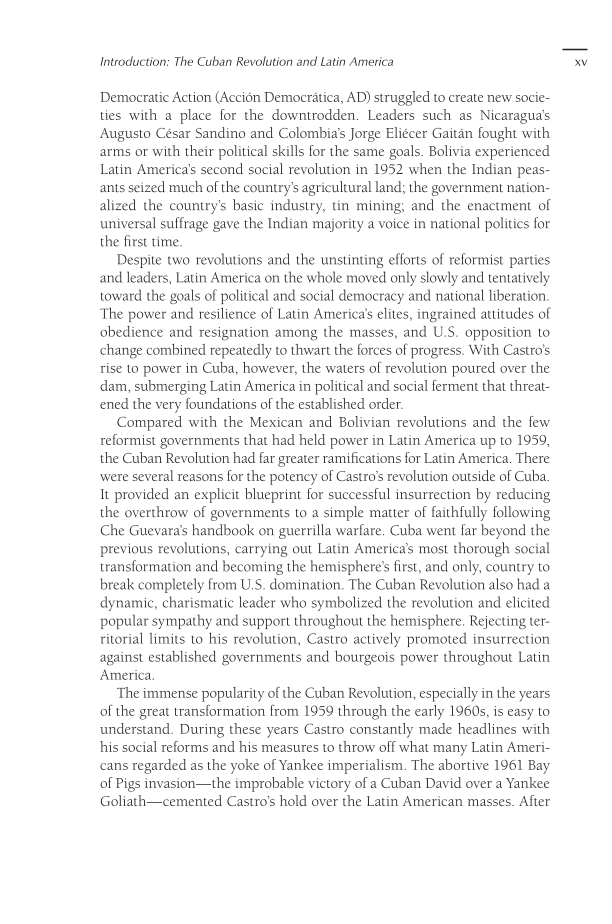Introduction: The Cuban Revolution and Latin America xv
Democratic Action (Acción Democrática, AD) struggled to create new socie
ties with a place for the downtrodden. Leaders such as Nicaragua’s
Augusto César Sandino and Colombia’s Jorge Eliécer Gaitán fought with
arms or with their political skills for the same goals. Bolivia experienced
Latin America’s second social revolution in 1952 when the Indian peas-
ants seized much of the country’s agricultural land; the government nation-
alized the country’s basic industry, tin mining; and the enactment of
universal suffrage gave the Indian majority a voice in national politics for
the first time.
Despite two revolutions and the unstinting efforts of reformist parties
and leaders, Latin Amer i ca on the whole moved only slowly and tentatively
toward the goals of political and social democracy and national liberation.
The power and resilience of Latin America’s elites, ingrained attitudes of
obedience and resignation among the masses, and U.S. opposition to
change combined repeatedly to thwart the forces of progress. With Castro’s
rise to power in Cuba, however, the waters of revolution poured over the
dam, submerging Latin Amer i ca in political and social ferment that threat-
ened the very foundations of the established order.
Compared with the Mexican and Bolivian revolutions and the few
reformist governments that had held power in Latin America up to 1959,
the Cuban Revolution had far greater ramifications for Latin Amer i ca. There
were several reasons for the potency of Castro’s revolution outside of Cuba.
It provided an explicit blueprint for successful insurrection by reducing
the overthrow of governments to a simple matter of faithfully following
Che Guevara’s handbook on guerrilla warfare. Cuba went far beyond the
previous revolutions, carrying out Latin America’s most thorough social
transformation and becoming the hemisphere’s first, and only, country to
break completely from U.S. domination. The Cuban Revolution also had a
dynamic, charismatic leader who symbolized the revolution and elicited
popular sympathy and support throughout the hemisphere. Rejecting ter-
ritorial limits to his revolution, Castro actively promoted insurrection
against established governments and bourgeois power throughout Latin
Amer i ca.
The immense popularity of the Cuban Revolution, especially in the years
of the great transformation from 1959 through the early 1960s, is easy to
understand. During these years Castro constantly made headlines with
his social reforms and his measures to throw off what many Latin Ameri-
cans regarded as the yoke of Yankee imperialism. The abortive 1961 Bay
of Pigs invasion—the improbable victory of a Cuban David over a Yankee
Goliath—cemented Castro’s hold over the Latin American masses. After

























































































































































































































































































































